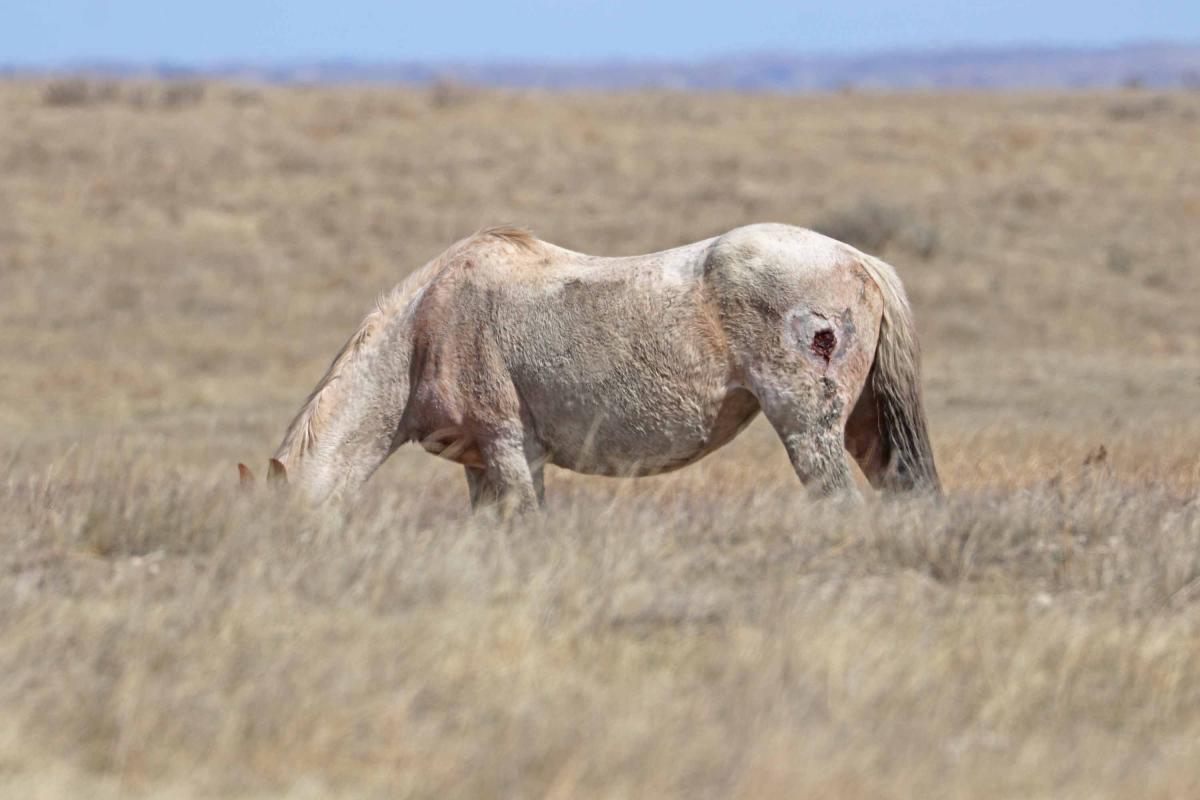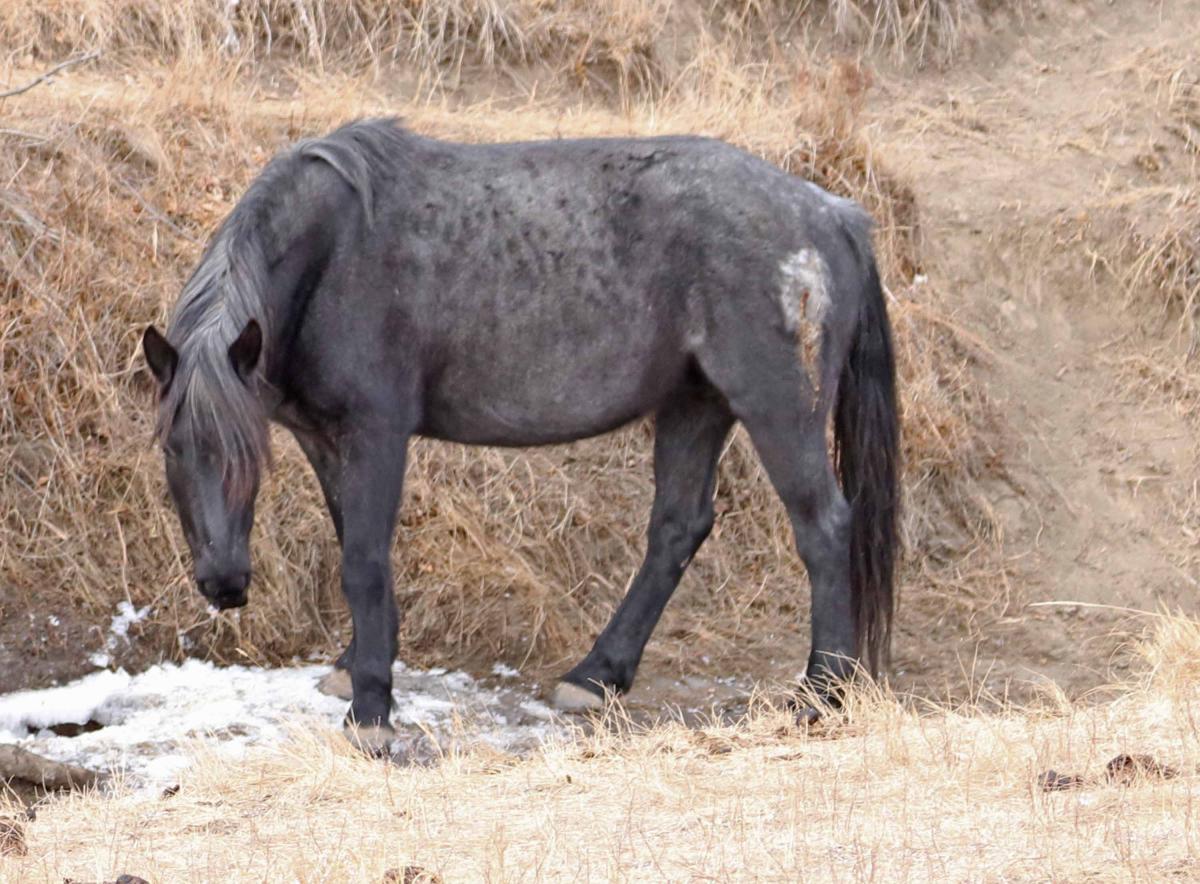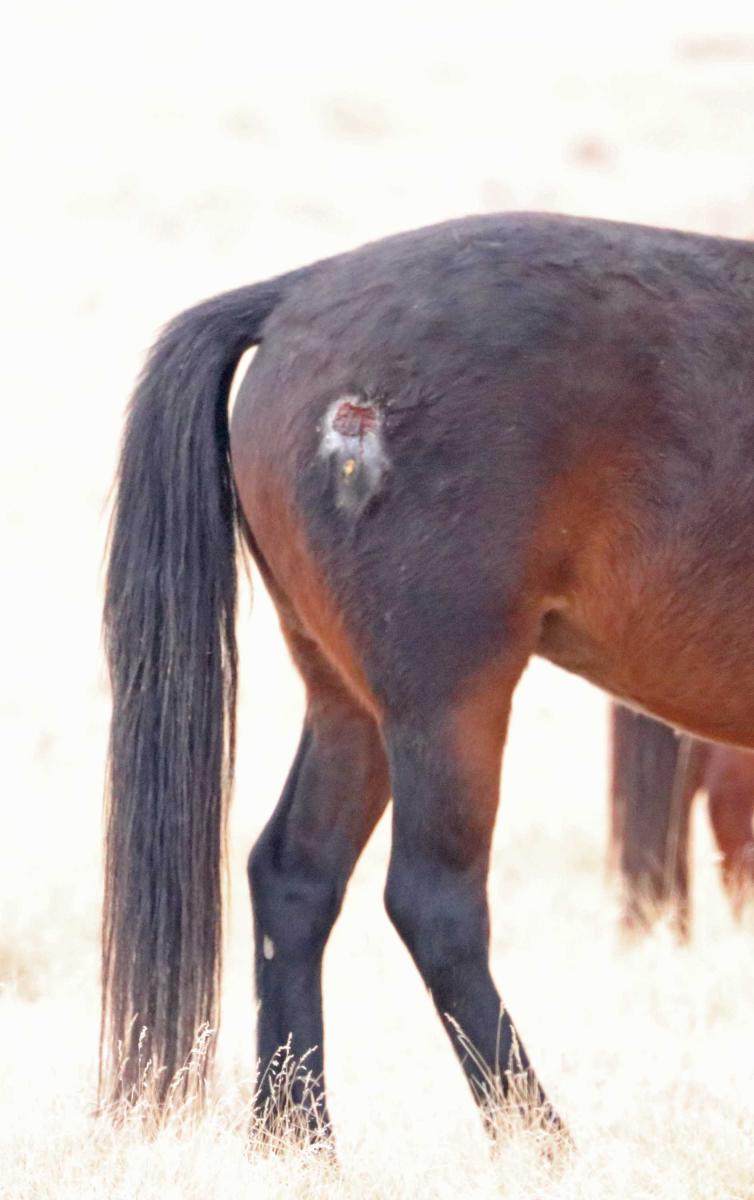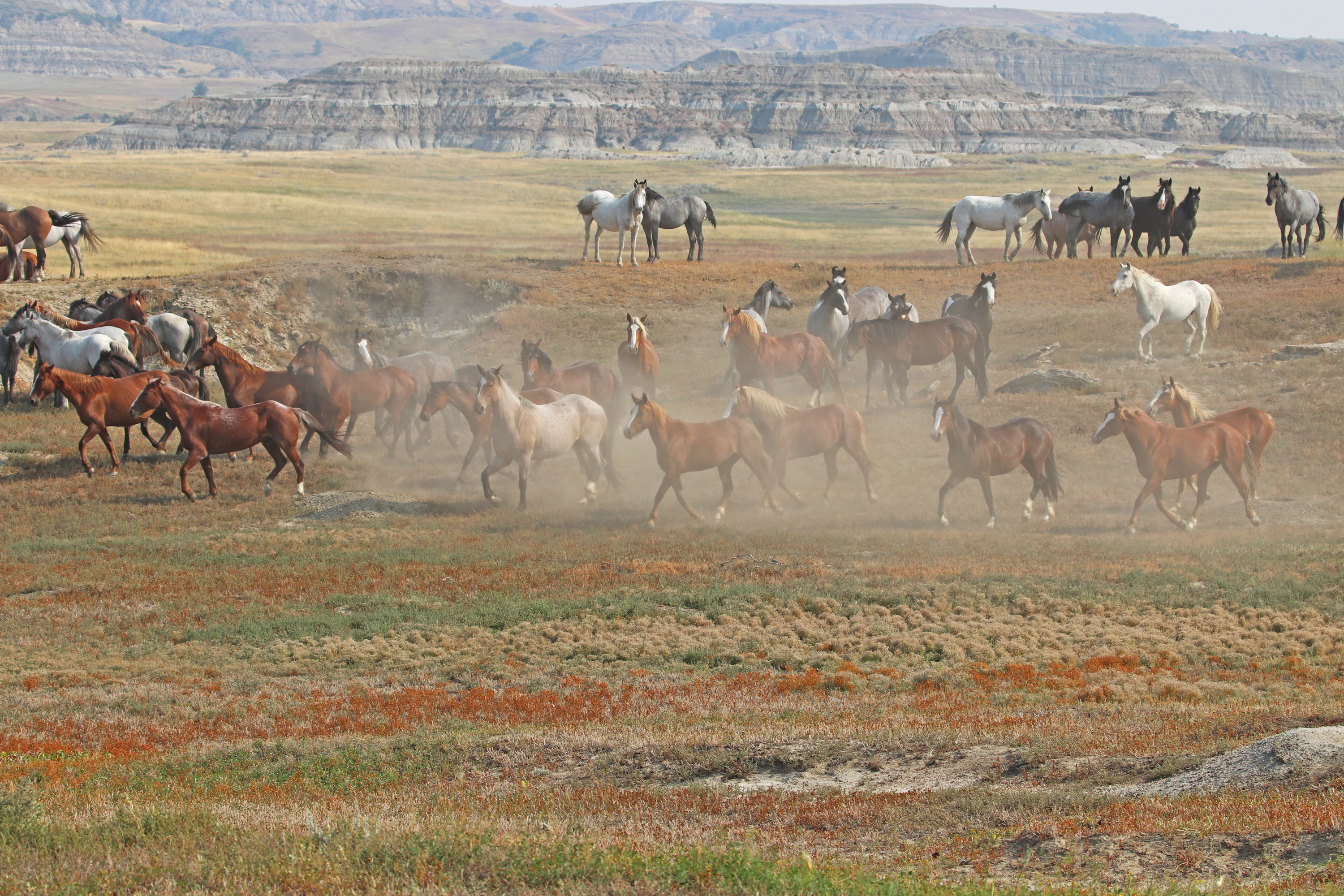By Mary Koncel, Project Coordinator
(April 14, 2023) The Theodore Roosevelt National Park (TRNP) is located in the badlands of North Dakota. Besides being home to almost 200 wild horses who have roamed this rugged landscape for hundreds of years, it has also been used as a laboratory for research on GonaCon as a fertility control for over a decade.
Based largely on this research, the Bureau of Land Management (BLM) is significantly expanding its use of GonaCon across the West in its Herd Management Areas (HMA) as its fertility control treatment of choice. At the same time, however, rumors persist that GonaCon has caused the sterilization of mares in the TRNP.
Recently, records from AWHC’s Freedom of Information Act (FOIA) requests have confirmed that sterilization of some of the Theodore Roosevelt (TR) mares has occurred as a result of GonaCon despite TRNP officials’ statements that it hasn’t and little public acknowledgment by the academic institution and other government agencies involved in the research.
The FOIA records also include discussions on the possible creation of a nonreproducing herd of wild horses in the TRNP using GonaCon, consistent with the National Park Service’s (NPS) preferred action in its proposed Livestock Management Plan (LMP) – gradually eliminating the wild horse herd from the TRNP.
GonaCon and Its Use in the TRNP
GonaCon is an immunocontraceptive vaccine that produces antibodies against gonadotropin-releasing hormones, which prevent mares from ovulating and from displaying sexual behavior.
In 2013, the National Academy of Sciences report on the BLM Wild Horse and Burro program cited PZP and GonaCon as two of the most promising fertility-control methods for free-ranging horses or burros. It recommended that further research was needed to assess the behavioral and contraceptive effects of GonaCon.
Since then, two research projects on GonaCon have taken place in the TRNP.
- Between 2009 and 2015, the NPS, Colorado State University (CSU), and the United States Geological Survey (USGS) undertook the first study to test the efficacy and behavioral effects of the GonaCon vaccine on wild horses in the TRNP. Results found that a single dose of GonaCon can cause moderate reductions in mare fertility and that behavior-wise, GonaCon-treated mares were somewhat comparable to pregnant mares.
- Between 2015 and 2020, the NPS and CSU partnered with the BLM to conduct another study to determine the optimum booster schedule; duration of effectiveness; and safety and physiological side-effects (if any) following booster vaccination with GonaCon. Results found that there were minimal behavioral effects and that a booster dose of GonaCon was highly effective as fertility control in mares – 91% average effectiveness over 4 years for animals treated with two hand-injected doses.
Field research ended in 2020, but the TRNP has authorized the continued use of GonaCon to contracept all remaining female horses who are eight months or older.
Although the largely tax-funded research was conducted by CSU in partnership with the NPS and several other federal agencies, TRNP never notified the public before embarking on these studies, nor invited the public to comment on its important decision to contracept all the mares with GonaCon beginning in 2020. For the latter, former TRNP Superintendent Wendy Ross signed a Category Exclusion (CE). According to the National Environment Policy Act, a CE is used when an agency determines that its action will not have any significant effect on the human environment. Therefore, neither an environmental assessment nor an environmental impact statement is required.
Adding to the lack of transparency is the TRNP’s policy not to answer questions from the public via emails, phone calls, or in-person meetings about the TR wild horses. Instead, the TRNP created a portal to respond to inquiries “to ensure that no one is left out of communications.”
However, the TRNP is selective about what it decides to respond to and post. Two years ago, for instance, AWHC emailed Ms. Ross requesting a meeting to discuss the management of the TR horses. Our questions included how TRNP personnel and the CSU GonaCon researchers coordinate to determine which mares will be vaccinated and which young horses will be removed, especially given biological concerns about inbreeding and genetic diversity. Ms. Ross responded that our questions would be answered on the portal, but this did not happen.
Is GonaCon Sterilizing the TR Mares?
In the past 12 months, at two public hearings on the LMP, two members of the NPS GonaCon research team, Dr. Jenny G. Powers (NPS, Wildlife Health Branch) and Dr. Blake E. McCann (NPS, TRNP’s Director of Resource Management and Science) stated that GonaCon did not result in sterilization.
During the Q&A at the 3/30/22 Civic Engagement Meeting for the LMP, Dr. Powers was asked if there is proof that any of the horses have been in any way sterilized by the GonaCon. Her response:
"We do have a couple of published papers showing that GonaCon is reversible, meaning that animals return to fertility post-vaccination. However, with any individual animal, it is possible that they could be permanently sterilized, and it is unknown at this time if our current herd has sterilized individuals or not. We'd have to play out the rest of their reproductive lives to know that."
Then, during the Q&A at the 1/13/2023 Virtual Public Scoping Meeting for the LMP, Dr. McCann was asked how many mares have become sterilized or not returned to fertility as a result of being treated with GonaCon. His response:
"So far as the specific question of sterility, I'm not aware of any animals that have been sterilized by GonaCon. And from our evaluation and published research, we believe that it is a safe agent to use for purposes of population control.
I have observed that animals are released from the effects of the contraceptive and they require boosters, so that's at least some indicator there that we have not a completely lasting effect forever, but it is something that has to be maintained over time. Similar to other contraceptives that are used for horses elsewhere.
However, emails and handwritten notes acquired from AWHC’s FOIA requests suggest otherwise – that sterility of the TR mares was an issue and was discussed among the GonaCon research team and the BLM as early as Fall 2019. For example, on October 29, 2019, Dr. Dan L. Baker (CSU, Animal Reproduction and Biotechnology Laboratory) emailed Dr. Paul Griffin (BLM, National Wild Horse and Burro Program Research Coordinator), asking for a visit to discuss “a future experiment with the TR horses that would address the question of permanent sterility and differences in hand versus dart injection of GonaCon.”
Then, on 9/16/2020, Dr. Baker emailed Paul Griffin, Terry Nett, Doug Eckery, and Jason Bruemmer the following:
"Sorry for the delay in getting back to you regarding my efforts to convince the park to continue evaluating GonaCon in treated mares. I have spent several hours of discussion with Blake and park staff trying to explain to them the importance of continuing to monitor the 19/24 mares that have not regained fertility since being boosted in 2013.
Based upon several of your suggestions, I have provided alternatives for continued monitoring of this group of horses using volunteers and the fecal estrogen assay that is being validated by Kathleen and Terry. I have also proposed capturing a subset of this group of mares and
transporting them to CSU for further investigations into whether they are permanently infertile or not and, if so, why. I know that Jenny and Paul Griffin have lobbied for continued evaluation with potential funding from the BLM and/or other sources.
The park has rejected all of our alternatives and I am convinced that efforts to pursue any collaboration will fail. It's depressing to me and a great loss of opportunity but in retrospect, I feel that, with the past cooperation from the park, our research at TR has been quite successful and we have be able to advance the understanding and application of this contraceptive vaccine in feral horses.
I'll be sending out a brief summary of our foaling results from 2020 and potential alternatives for future publications of our research findings.
Thanks for your support. Give me a call if you have questions.
Dan"
The handwritten notes from telephone calls between members of the GonaCon research team and the BLM* provide more information on the plans to assess the mares who had not returned to fertility as well as their reproductive systems.
Besides the proposal to capture the apparently sterilized mares and transport them to CSU, the notes state that the university offered to provide lifetime care for the mares. Additionally, participants in the calls discussed two field experiments on the TRNP. The first involved chemically immobilizing 10 mares treated with GonaCon in 2013 and 10 control mares with “BAM,” which Dr. McCann said he could provide, collecting serum, and running tests to measure antibody titers. However, it appears this field experiment was scratched due to the expense of running those titers tests.
Further, in early August of presumably 2020, in what appears to be a response to Dr. Baker’s thoughts on the continued monitoring of the GonaCon mares, the notes record Dr. McCann as stating that the TRNP “was going into a management phrase” and that darting all the mares in the Park would start in October. Following those comments is a note that says “Nonreproducing herd of animals” and another that says “Darting/selling 40 foals/year has been a lot of work.”
A final note states, “Groups have threatened a lawsuit to stay the mgmt application…”
*The handwritten notes are sometimes difficult to decipher Many are undated, but AWHC believes they are records of meetings in 2019 and 2020 as that was the timeframe for our FOIA request.
Injection Site Reactions
A 2018 article on the GonaCon research in the TRNP found that visible reactions at the injection sites of vaccinated mares are common. These reactions range from abscesses – an open sore usually with fluid drainage or discharge – to swelling – a raised area of tissue of variable size and shape with no visible fluid drainage. Data from the article includes the following:
- After a single vaccination with GonaCon in 2009, approximately 72% of treated mares (21/29) displayed a visible reaction at the site of injection.
- At the 2013 roundup and revaccination, 81% (21/26) of vaccinated mares continued to have palpable swelling at the original site of vaccine injection.
- Like initial vaccination reactions, during the post-revaccination, approximately 50% (13/26) of mares continued to show swelling on the left hip at the site of the 2009 injection and 50% developed a reaction on the right hip at the site of revaccination in 2013.
The research also found that swellings were persistent in about half of the GonaCon treated mares at one or both Injection site reactions 3 years after revaccination but that none of the mares displayed lameness through the 8 years they were observed.
Ultimately, the researchers concluded that “until additional research suggests otherwise, the presence of injection site lesions following GonaCon vaccination do not pose a serious contraindication associated with the application of this vaccine, and there appear to be minimal long-term effects on individual animal welfare.”
According to the handwritten notes, the second field experiment focused on the injection sites. The experiment required capturing mares via chemical immobilization with “BAM” and then ultrasound of the injection site lesions. Its purpose, however, was not to examine the effects of the injection site reactions from GonaCon but to compare the difference in the tissue between vaccinations delivered by hand injections versus remote darting to help understand the fertility status of the mares. It appears that this experiment also did not move forward.
To AWHC’s knowledge, no additional research has been conducted on the long-term effects of the injection site reactions from GonaCon, so it’s unknown if there have been any serious contraindications.
For years, local followers of the TR horses have photographed mares that document the injection site reactions. They include the following images of weeping abscesses and large areas of hair loss:



Conclusion
The TRNP study on GonaCon was intended to advance the humane and sustainable management of wild horses with reversible fertility control. Based on AWHC’s FOIA records, several questions about its use need further examination, including whether it is reversible. The FOIA records also suggest that the TRNP study became a stepping stone to the NPS’s preferred action in its proposed LMP – the gradual elimination of this culturally, historically, and ecologically important wild horse herd in North Dakota.
AWHC will continue to file FOIA requests for records on the use of GonaCon on the TRNP and other wild horse herds. We’ll keep you updated.


